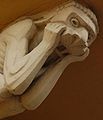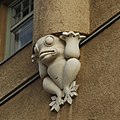Grotesque (architecture)

In architecture, a grotesque or chimera is a fantastic or mythical figure used for decorative purposes. Chimerae are often described as gargoyles, although the term gargoyle technically refers to figures carved specifically as terminations to spouts which convey water away from the sides of buildings. In the Middle Ages, the term babewyn was used to refer to both gargoyles and chimerae.[1] This word is derived from the Italian word babuino, which means "baboon".
Bridaham, in his book Gargoyles, Chimeres, and the Grotesque in French Gothic Sculpture points out that the sculptors of the Gothic cathedrals in the twelfth and thirteenth centuries were tasked by the Pope to be "a preacher in stone" to the illiterates who populated Europe at the time. It fell to them to not only present the stories of the Bible but also portray the animals and beings who populated the folk lore of the times. Many of these showed up as grotesques and chimerae, carved on the buildings.[2] Some critics dismissed the use of the grotesque such as Frances Barasch, who maintained that it is an idle toy and not of any great use. It is also argued that it perpetuated superstition instead of articulating what is real or the truth.[3]
The meaning and use of the grotesque is also changing in architecture. Aside from the sculpture, for instance, the term has been used to describe the search for the abnormal or the representation of caricature.[3] There are also scholars who use the architectural definition of grotesque as a term for disharmony.[4] These include Peter Eisenman, a Deconstructivist architect who used this conceptualization in his work. Particularly, he used the term in presenting a stylistic opposition to the form of aesthetics that is identified with the Kantian notion of the sublime in architecture.[4]
Gallery[]
Grotesque by Nathaniel Hitch on exterior of 2 Temple Place, London

Detail from Tors gate 1 in Frogner, Oslo, Norway. The Art Nouveau house by architect Syver Nielsen, 1913.
A frog statue supporting a pilaster on the Agronomy House in Helsinki, Finland
Architectural monument, Bayern

A red Brick and Terracotta Gothic styled Library, designed by Martin and Chamberlain and completed in 1893
See also[]
- Chimera (mythology)
- Chiwen
- Darth Vader grotesque
- Gargoyle
- Grotesque
- Mascaron (architecture)
- Nightmares in the Sky
- Onigawara
- Shachihoko
- Sheela na gig
References[]
- ^ Janetta Rebold Benton (1997). Holy Terrors: Gargoyles on Medieval Buildings. New York: Abbeville Press. pp. 8–10. ISBN 0-7892-0182-8.
- ^ Bridaham, Lester Burbank, Gargoyles, Chimeres, and the Grotesque in French Gothic Sculpture, introduction by Ralph Adams Cram, Architectural Book Publishing Co., Inc, New York, 1930 p. ix
- ^ Jump up to: a b Smith, Kendra Schank (2012). Architects Sketches. Burlington, MA: Architectural Press. p. 107. ISBN 978-0-7506-8226-8.
- ^ Jump up to: a b Graafland, Arie (2000). The Socius of Architecture: Amsterdam, Tokyo, New York. 010 Publishers. p. 55. ISBN 978-90-6450-389-4.
| Wikimedia Commons has media related to Grotesques. |
- Grotesques
- Visual motifs
- Objects believed to protect from evil
- Architecture stubs




